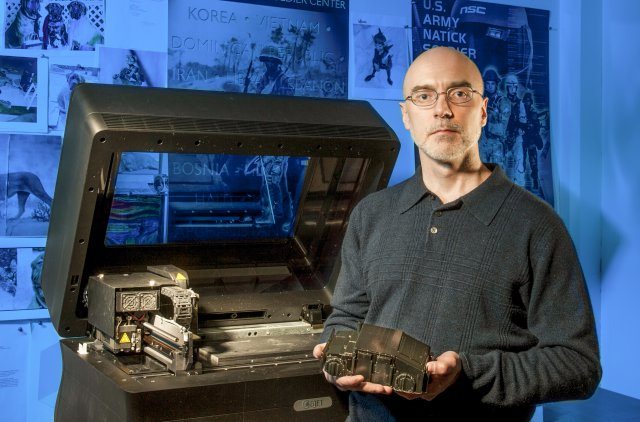Welcome to Steve Smith’s world. It’s a place where big is small, small is big and anything is possible.
Smith works as a graphic designer at the U.S. Army Natick Soldier Research, Development and Engineering Center. The 3-D-printer guru uses the medium to design, make and improve displays. He works closely with NSRDEC scientists and engineers to create something visual and tangible so the average person can garner a better understanding of NSRDEC-developed products and concepts.
“The models help (subject matter experts) explain themselves to their audience more clearly,” Smith said. “People have something they can pick up and see how it works. They can see what the physical science is behind it. It definitely helps a lot of people to see things in a concrete form.”
Smith uses Computer-aided Design, or CAD, to create virtual, working models before they are sent to a 3-D printer. The printer uses a liquid polymer exposed to ultraviolet light to create the actual models.
The scientists and engineers tell him what they envision, and he develops the models. The process can sometimes give scientists and engineers a little bit of added insight.
“It can help point out when something doesn’t work. We need to find a different footprint for this shelter. Or sometimes I can see that parts are colliding,” Smith said. “I’m not an engineer by any means, but there is definitely some back and forth. You can pick up some problems before it even gets to the printing stage.”
Although Smith uses 3-D printing primarily for model creation, he sometimes uses it to create prototypes.
“We have our own prototype facility, but I’ve done some occasional small jobs. For example, I did an electrochemical cell for a group in the food lab,” Smith explained. “So, I can produce functional things, but a lot of it is conceptual. Most of what I do is illustrative.”
Smith creates scale models of architecture and existing machinery. For example, he created a scale model of the layout of the Natick Soldier Systems Center and created a 1:8 scale Humvee, which included a way to insert an accelerometer for wind-tunnel tests. The model will be used to simulate the wind effects on the vehicle while sling-loaded under a helicopter.
He also works on notional concepts to illustrate what can be done in the future.
“Instead of building an entire Future Warrior that has to be worn, we can make a ‘GI Joe’-scale figure and configure him with different equipment and that kind of thing.”
In addition to being able to scale down large products and conceptual ideas to a small size, Smith’s work can also provide an exploded view of items that use nanotechnology, focusing a magnifying glass to help people see the big picture.
“Think about things that are at the nanoscale,” Smith said. “You can’t take people on a tour of material that is at nanoscale, but you could build a big model that represents how this thing works at the nanoscale.”
The process of using 3-D printing to create models has some advantages over older methods.
“In some ways 3-D printing is easier (than casting and making molds),” Smith said. “There is so much digital material out there in the public domain, either for free or that you can purchase. I wouldn’t have to sculpt a human figure from scratch. If you wanted to make a human figure, you could find one and then modify it to your own needs. There is no mess involved. There is an undo button.”
Just as with every technological advance, however, much is gained but something is lost.
“It can cut down on the amount of time someone spends making the actual model,” Smith said. “Right now, there is still something lost in the process, artistically speaking. From an aesthetic purist point of view, it is kind of like comparing vinyl to CDs. It looks faux realistic, but it doesn’t look like a human being made it by hand. It loses that kind of charm. ”
Smith believes that 3-D printing may also prove to be a way to manufacture multifunctional materials. It could be used to create modular shelters. In the private sector, it is already being used to create common replacement parts, such as nuts, bolts and washers.
“It’s going to get interesting, because they are starting to work with metals. So, you can print with metals,” Smith said. “It will be interesting to see the effect on manufacturing. If people can do the manufacturing here (in the United States) at a fraction of the cost, there won’t be the need to go overseas. There are still a couple of stumbling blocks, technologically speaking. Again, producing stuff out of metal is going to be a big leap.”
Also, 3-D printers are getting faster all time, and some of the newer models have the ability to mix materials. The technology and its applications are becoming more and more commonplace.
“It’s really a blossoming field. There are so many different avenues. It could go into art, manufacturing and biological devices,” Smith said. “These printers have been around for a long time, but the cost of the machines was prohibitively high. Now, it is kind of like when the VCR and the camcorder got to the point when most people could afford to purchase them. It’s gotten to that level.”










